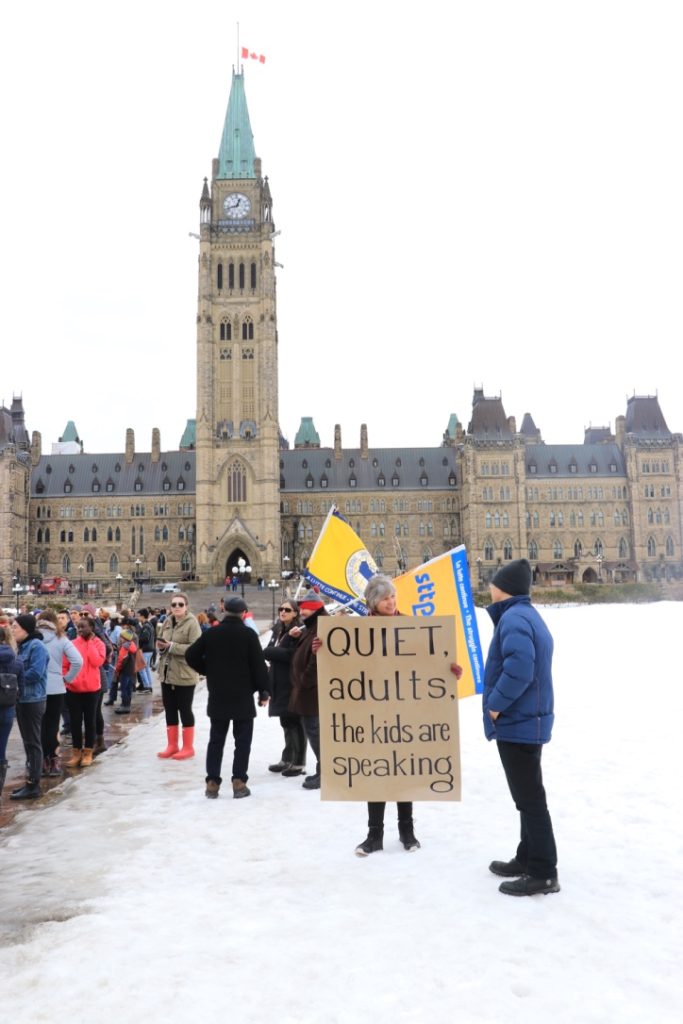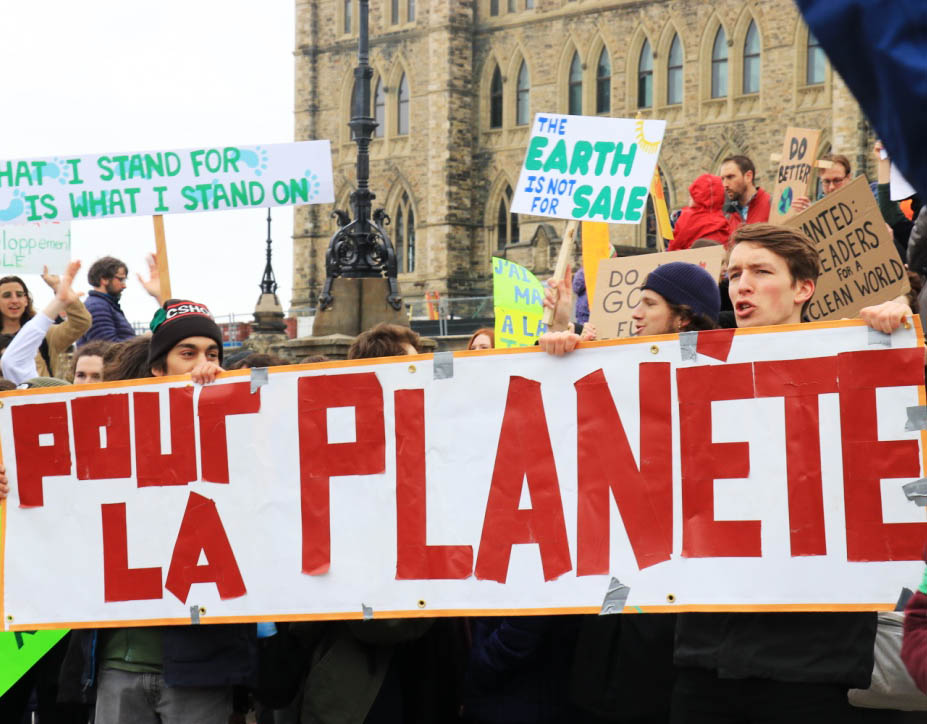A little over a year after Greta Thunberg first began the school strike for climate, the first Global Climate Strike will take place in Canada and across the world from Sept. 20 to 27.
The first climate strike inspired by her saw students in more than 100 countries protest and demand immediate climate action by their governments on March 15.
In Canada, another student-led climate walkout took place on May 2, and many people have continued Thunberg’s tradition by protesting in different locations every Friday since then.
“[Canadians] are amongst the biggest polluters.” – Francois Geoffroy, organizer with Earth Strike Canada
Unlike the climate walkouts by Extinction Rebellion on March 15 and May 2, however, the upcoming Global Climate Strike is about more than just a day of climate activism—it is an entire week dedicated to protest and saving the planet.
The strike is also different because while it continues to be student-led, it invites everyone to walk out of their workplaces and homes to join young climate strikers.
“I remember being 8 years old—with my parents—I probably took a day off school because I was home-schooled partially, and took the time to watch a documentary,” Tao Orion, a former University of Ottawa student who left his studies to become a climate activist with Earth Strike Canada, said.
“That scared me, and I really didn’t know what to do, and I really didn’t understand what I was seeing at that age.”
Orion, like many other Canadians, said he is concerned about Canada and the world’s changing climate.
Canada is warming at twice the rate as the rest of the world, according to a report released on April 1 by Environment and Climate Change Canada, called Canada’s Changing Climate. The possible impacts of this includes increased precipitation, and the increased possibility of extremely hot temperatures.
THE SCIENCE
The impact of rising temperatures would be an increase in variability, said Ian Black, a climatologist with CBC Ottawa.
“Some summers might be much hotter than we’re used to, or some summers could be much cooler or wetter than we’ve seen,” he said. “More often than not moving forward you’d have more heatwaves in the summer, longer heatwaves, longer droughts. Or conversely, extreme wet summers like we saw back in 2017.”
“The same goes for winter—you could have winters where you don’t have snow until the middle of January,” he added.
The federal government’s official website also states that future warming will be accompanied by other changes, such as the amount and distribution of snow and ice, dry spells and droughts, and forest fires.
The changes in Canada’s climate are a direct result of its emissions, said Francois Geoffroy, a national organizer with Earth Strike Canada.
“Canadians are big polluters. If we look at the carbon dioxide we emit per person, we are amongst the biggest polluters,” he said.
Canada is the third-largest country for greenhouse gas emissions per capita, with a 17 per cent increase in total emissions between 1990 and 2010, according to a 2013 report by the Conference Board of Canada.
“With the enormous quantity of greenhouse gases we emit and the way we export our pollution, of course we have an immense role to play in the challenge we are currently facing,” Geoffroy added.
“Canada must do its part because as an industrialized country, not only do we emit more, but we have to be a role model—we have to show that industrialized nations can do what’s necessary.”
ORGANIZING
Orion left his studies to become the provincial organizer for Ontario with Earth Strike Canada, an organization demanding immediate climate action from governments and corporations.
“I dropped out of school to be doing this,” he said. “We’re in a really dire situation right now, and it’s wrong to be sitting at home and doing nothing.”
Orion is planning to set up a tour to create Earth Strike chapters all across Ontario as part of what he called “radical activism volunteering.”
“We’re going to make sure that people that are new to activism understand that we’re giving them permission to be radical,” he said.

Geoffroy, on the other hand, emphasized the need for striking.
“We have been doing marches and protests for a while now in climate activism, but if we think about the way we can generate more people and apply concrete pressure, we have to learn from the lessons of the past,” he said.
“We first have to reach people that are not aware of the urgency of the crisis via their organizations, so unions are a great way to do that—talk to workers, to have a discussion with them, and to try to co-create scenarios that can bring the movement forward,” he added.
“We also have to apply real pressure where it hurts, so we need to think in terms of economic pressure, so striking is really the next move.”
THE ROLE OF YOUTH
A whole week is a way to show governments and industries what climate activists are willing to sacrifice, said Erin Fletcher, a highschool student at South Carleton in Ottawa.
“I think that young people bring a unique sense of both urgency and also creativity to these kinds of fights and to these kinds of processes.” Akilah Sanders-Reed, member of Youth Climate Intervenors
Fletcher, like other youth activists, said seeing another person her age like Greta Thunberg get involved in climate activism inspired her to do the same.
Thunberg is a 16-year-old from Sweden who has missed school to sit outside the Swedish parliament since last August, demanding politicians to bring the country in line with the Paris Climate Agreement.
“Greta is such a great leader, and she’s very determined,” said Fletcher.
According to Akilah Sanders-Reed, a member of the Youth Climate Intervenors, an organization protesting the construction of the Line 3 pipeline that will run from Canada to the United States, youngsters bring with them certain traits that adults do not.
“I think that young people bring a unique sense of both urgency and also creativity to these kinds of fights and to these kinds of processes,” she said.
“We showed up and asked questions that other parties weren’t willing to ask, and when we talked about why it’s important to be fighting this pipeline to our communities, and why we had chosen to take on this really big role for ourselves, people really wanted to show up for that,” she said of her work as an intervenor.
When he thinks of climate change, he is reminded of his kids and their future, said Geoffroy.
“My kids are 11 and 13 years old, and for them it’s not only their old age that is in question,” he said.
“When they will be my age, they will live in a world marked by hunger and violent conflicts. For me, it’s my old age, but for them, it’s their adult life. So, I think it feels more urgent for them because it’s the very basic opportunity of having an adult future.”
“They will have to live with the consequences longer than we do,” he added.
The reason youngsters are increasingly becoming involved in climate activism is because they have been failed by adults, according to Orion.
“The adults aren’t understanding the consequences of the decisions they’re making for people my age and younger, and it’s important for the people, and the well-educated, passionate youth that are leading this movement to actually be included too,” he said.
“The most frustrating part about this work is seeing the real people who could actually do something just totally drop the ball.”
It isn’t just adults who are unwilling to make changes, but politicians and governments too, he said.
“I think young people are really sick of being told that the changes we need in order to combat the climate crisis together, at the scale we need to, are too much—that they’re politically not possible.”
THE NEXT STEPS
The next step in the climate movement is pushing for big corporations and industries to be held accountable, according to Orion.
“I’m so angered by seeing messaging out there about climate change and what you can do being messaged to people at an individual level—take out your recycling, compost, walk to school, take your bike—all these things,” he said.
“People have to live regular lives, and we can’t put all the onus on the individual. It’s too much pressure on people—it’s just not fair to them—and they’re not the real causes of this problem.”
Geoffroy said he agreed.
“The individual actions are clearly insufficient, and they have always been,” he said.
“We’ve been conned into thinking that just by doing our part as individuals, we could do something, but clearly, challenges of this magnitude cannot be addressed by individual actions.”
“It needs a drastic change in the way we live, and the way we organize, and the way we plan or manage our economies,” Geoffroy added.
“It would be weird to have a very polluting lifestyle and to ask organizations to do their part, but if we really think in terms of who has the power to change things, it’s not the individuals—it’s the governments, the bigger organizations and the corporations.”
The Global Climate strike is a step to address that because it is taking place in the same week as the 2019 United Nations Climate Action Summit.
According to UN press release, UN Secretary-General António Guterres is calling on all leaders to come to New York on 23 September with concrete, realistic plans to enhance their nationally determined contributions by 2020, in line with reducing greenhouse gas emissions by 45 per cent over the next decade, and to net zero emissions by 2050.
“We’ve come so far— these strikes have really put pressure on politicians,” she said. “These politicians have started to talk quite a bit more about the climate crisis.”
“It is being risen as an issue, and we are making a difference,” Fletcher said of the strikes and the youth activists leading them.
Featured image by Meral Jamal.






